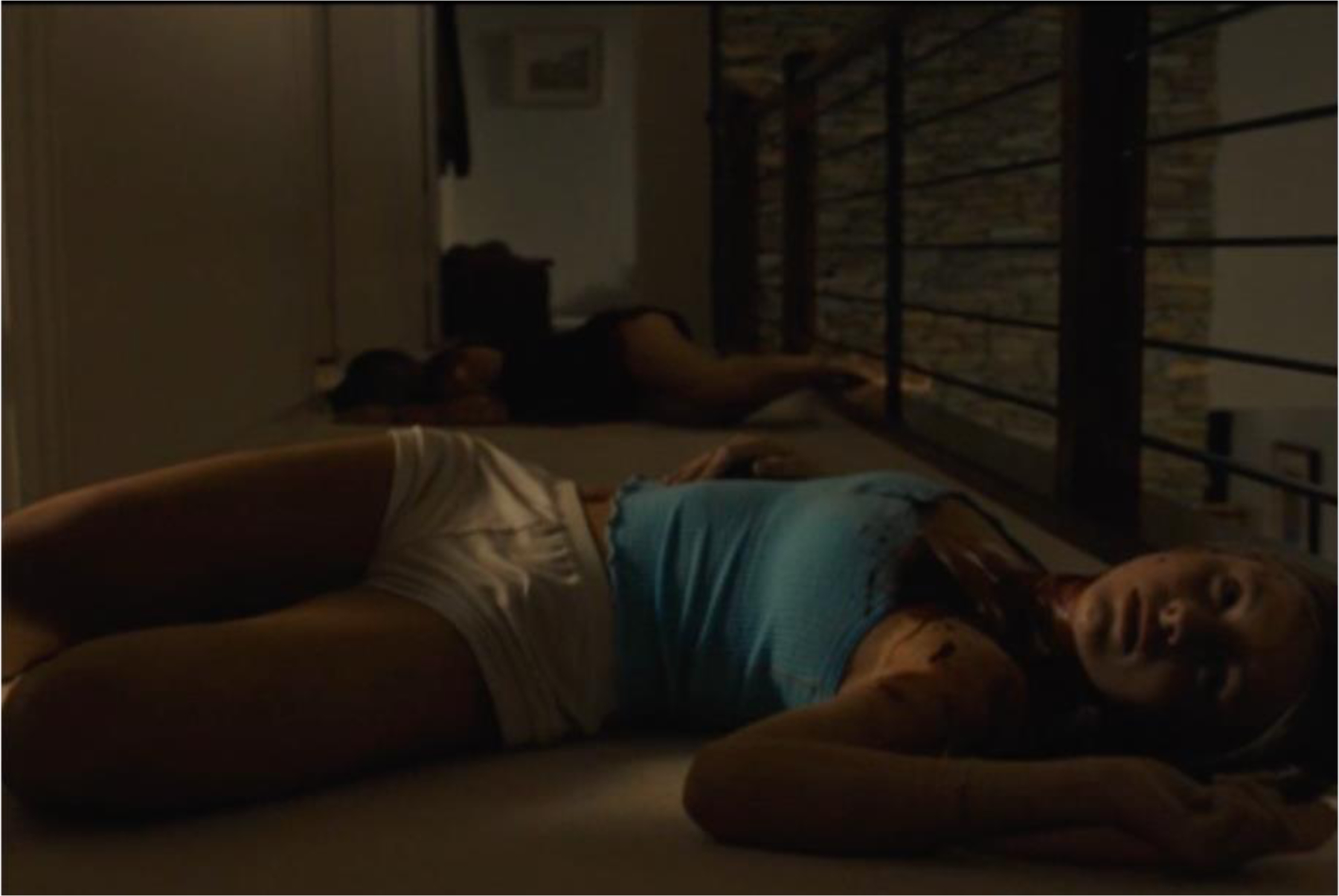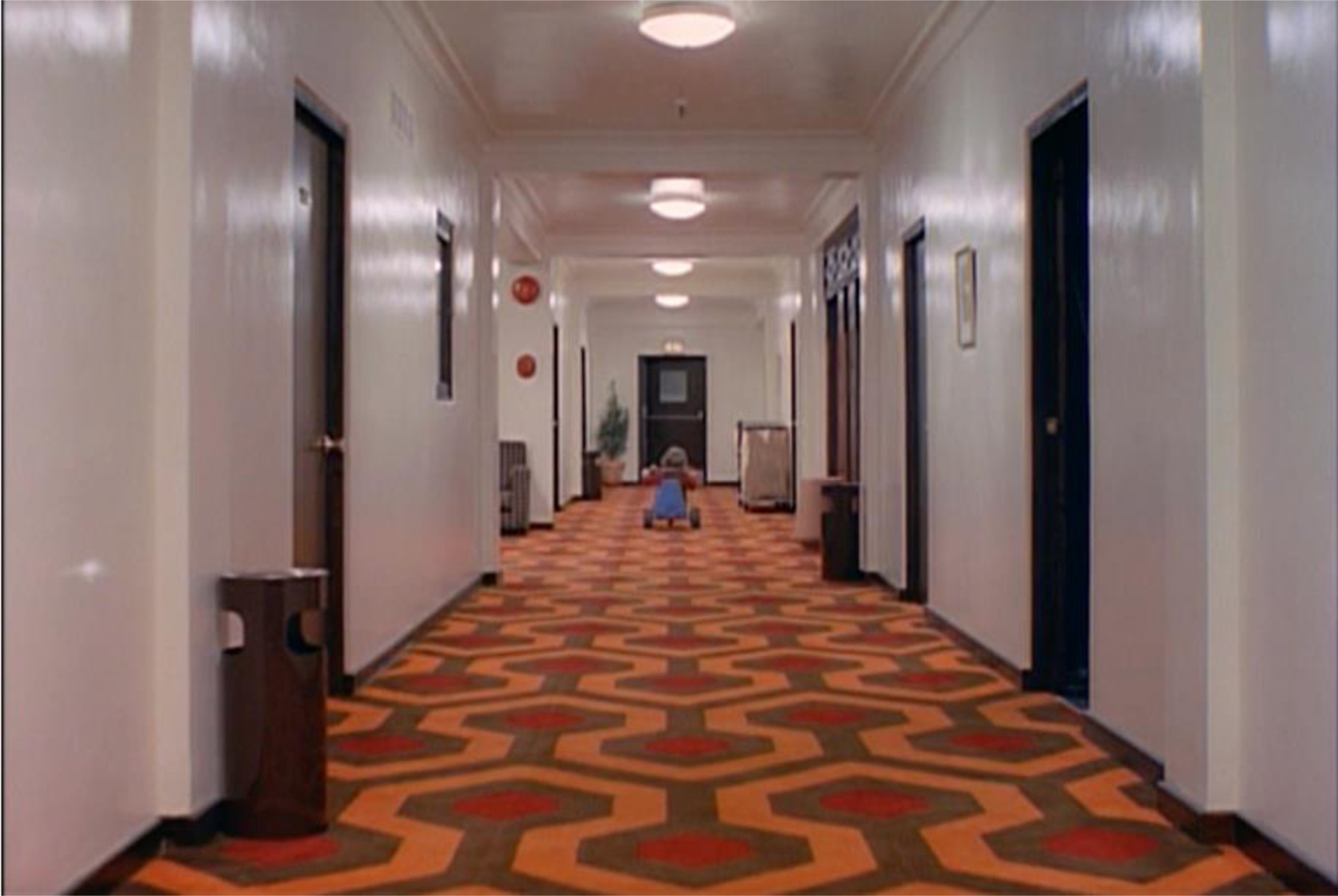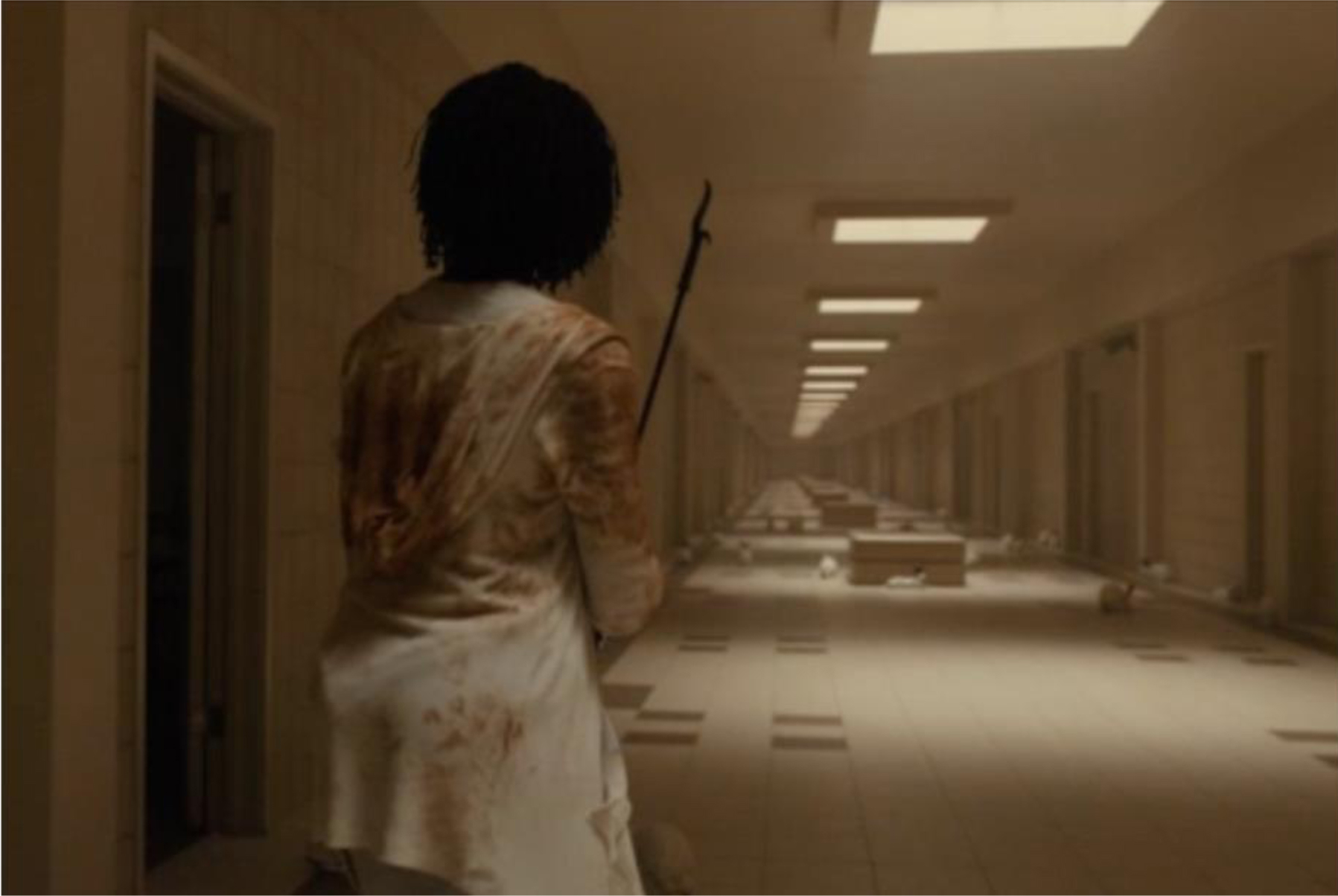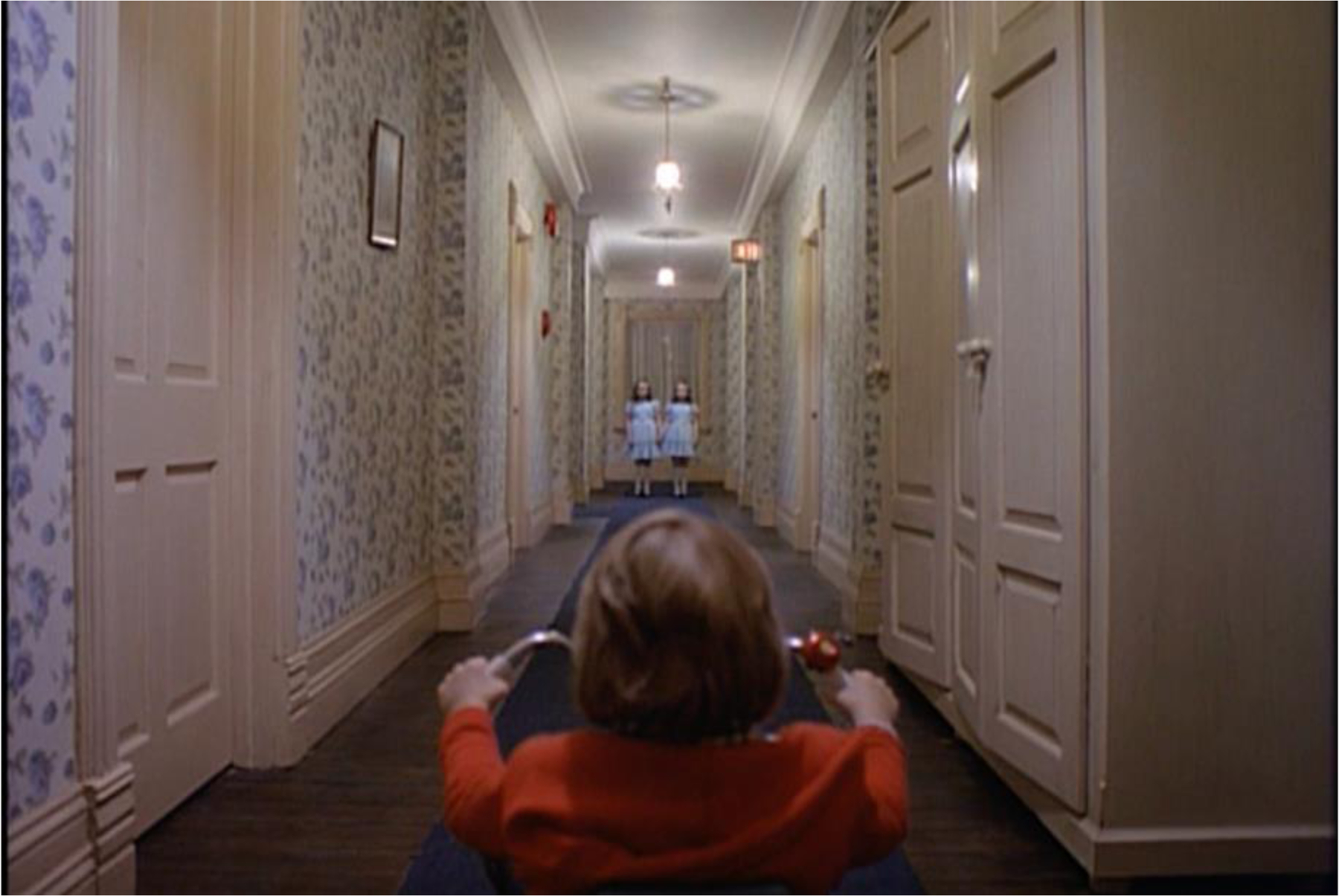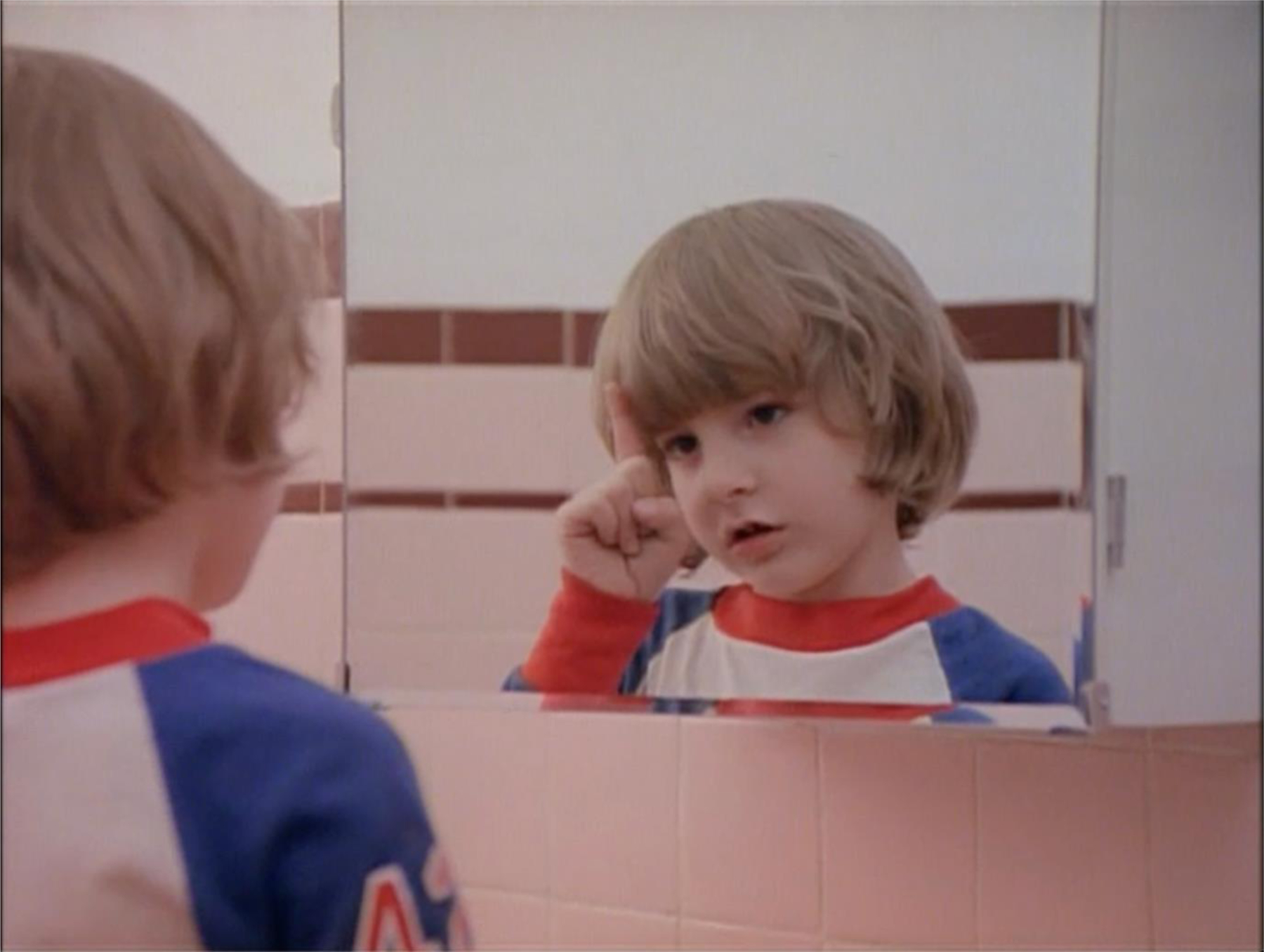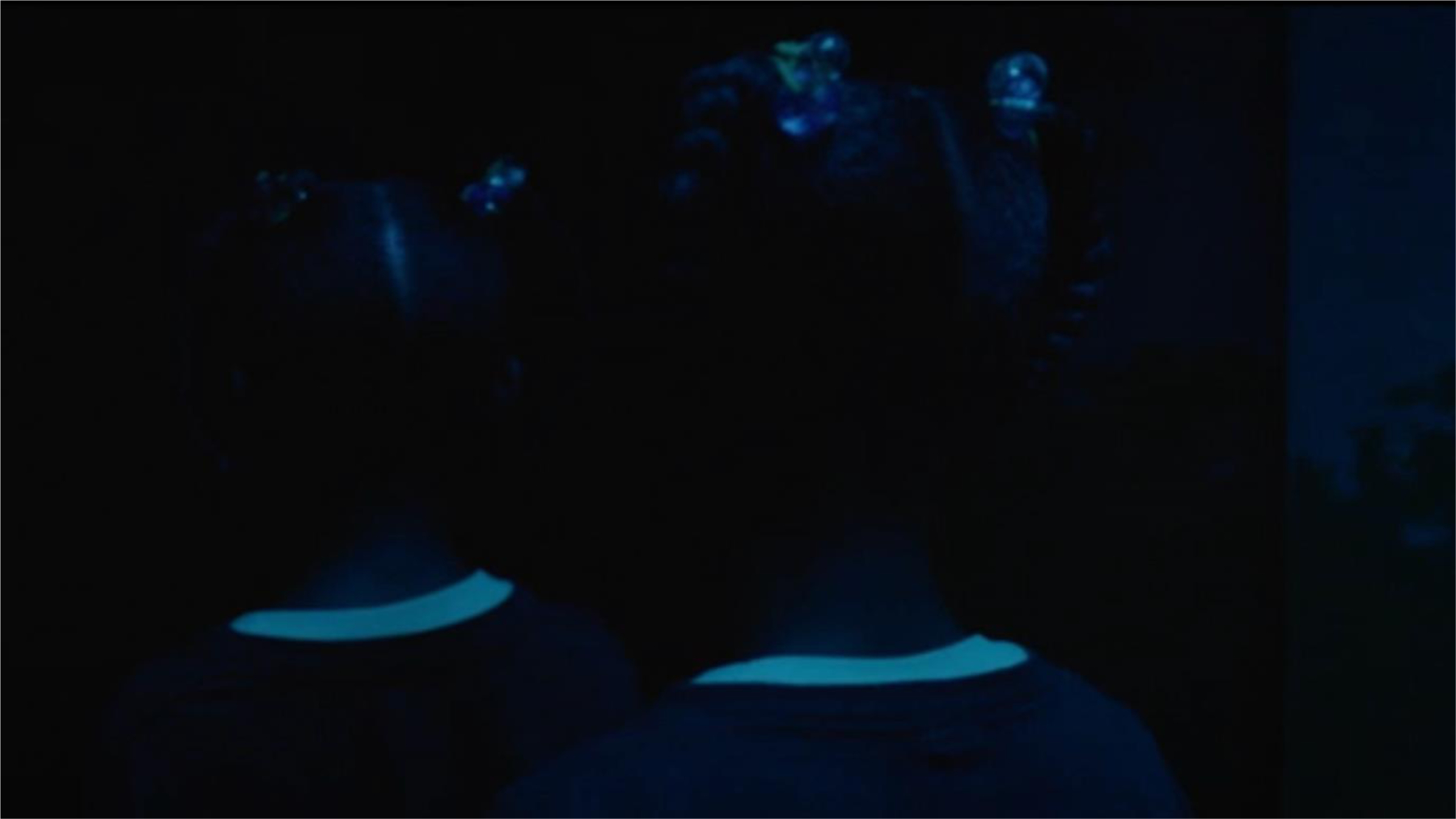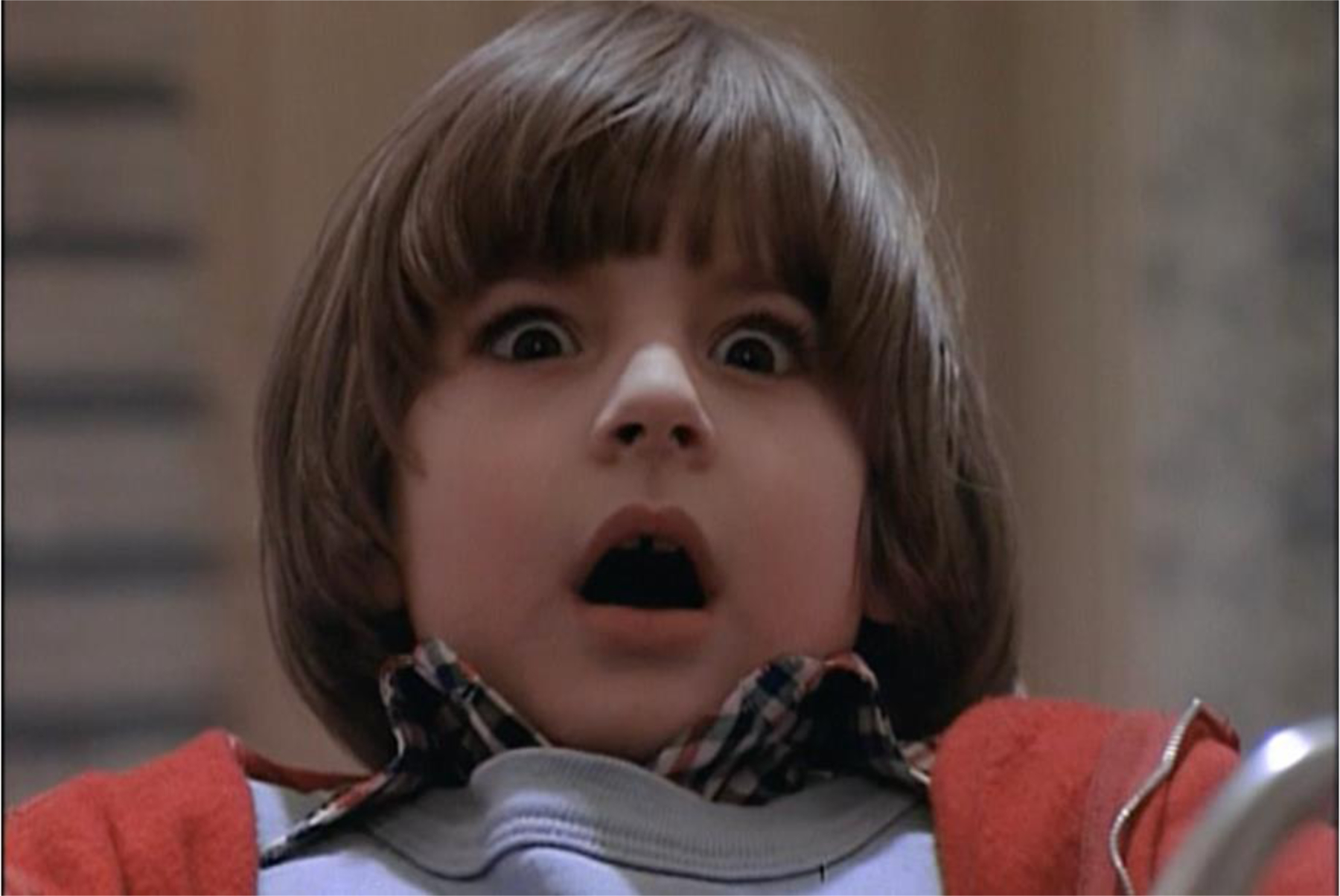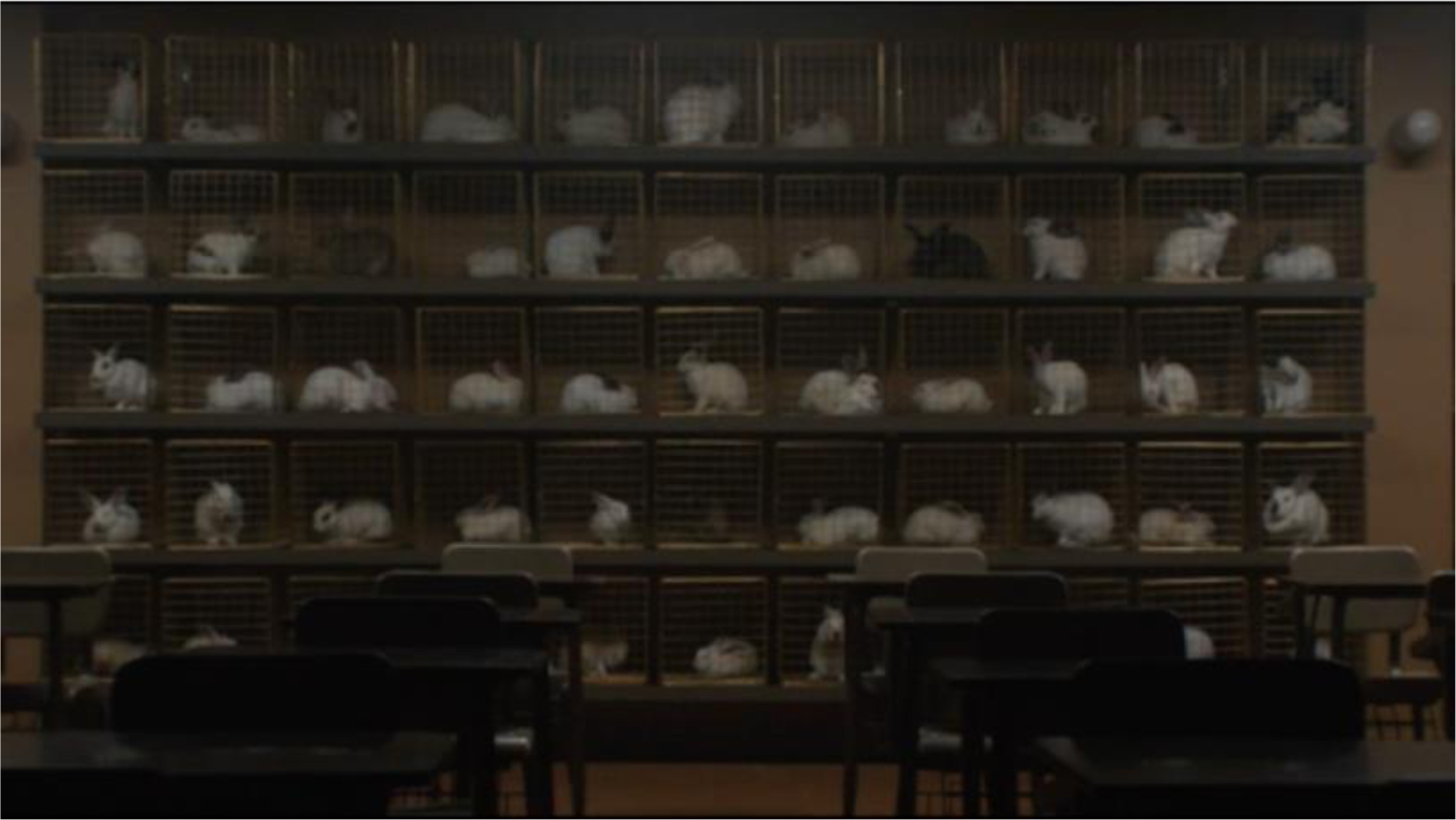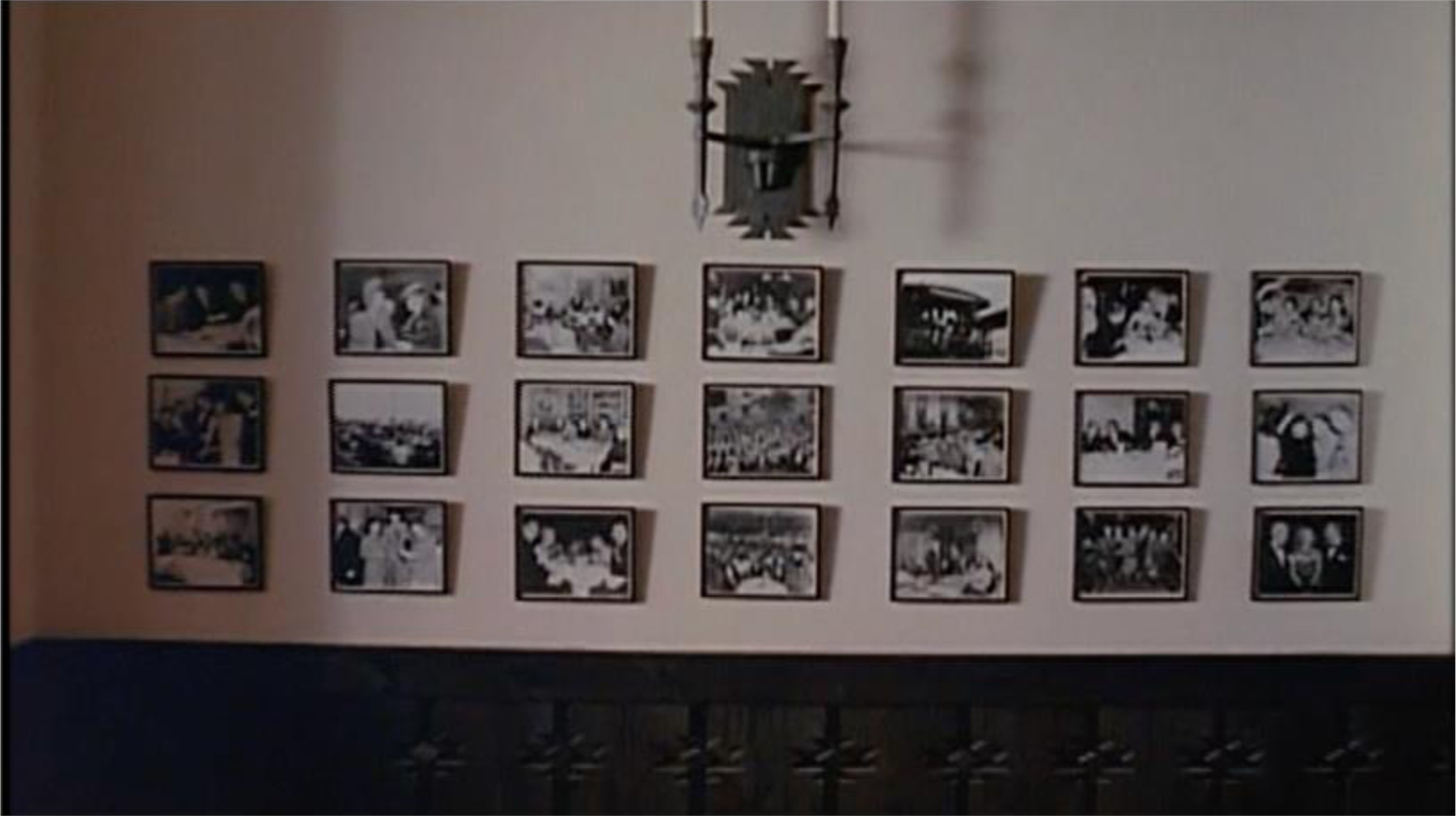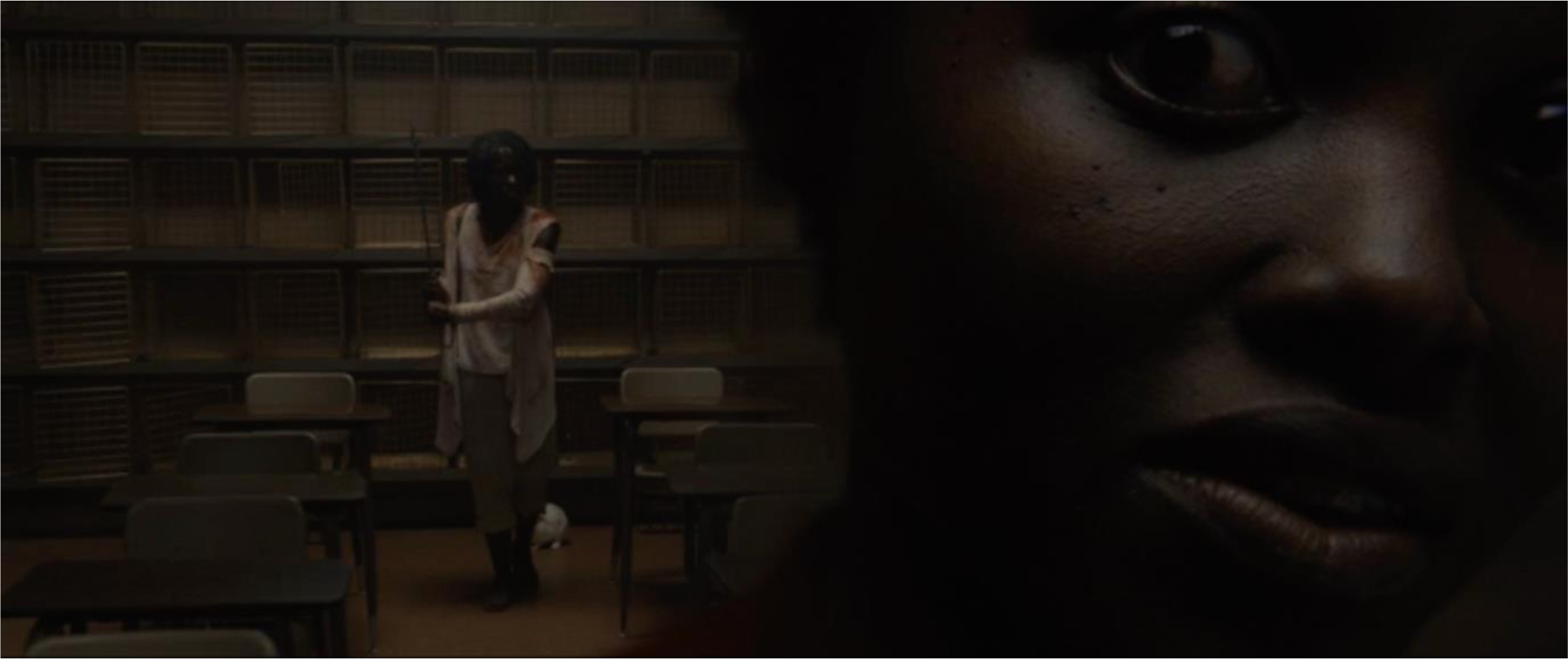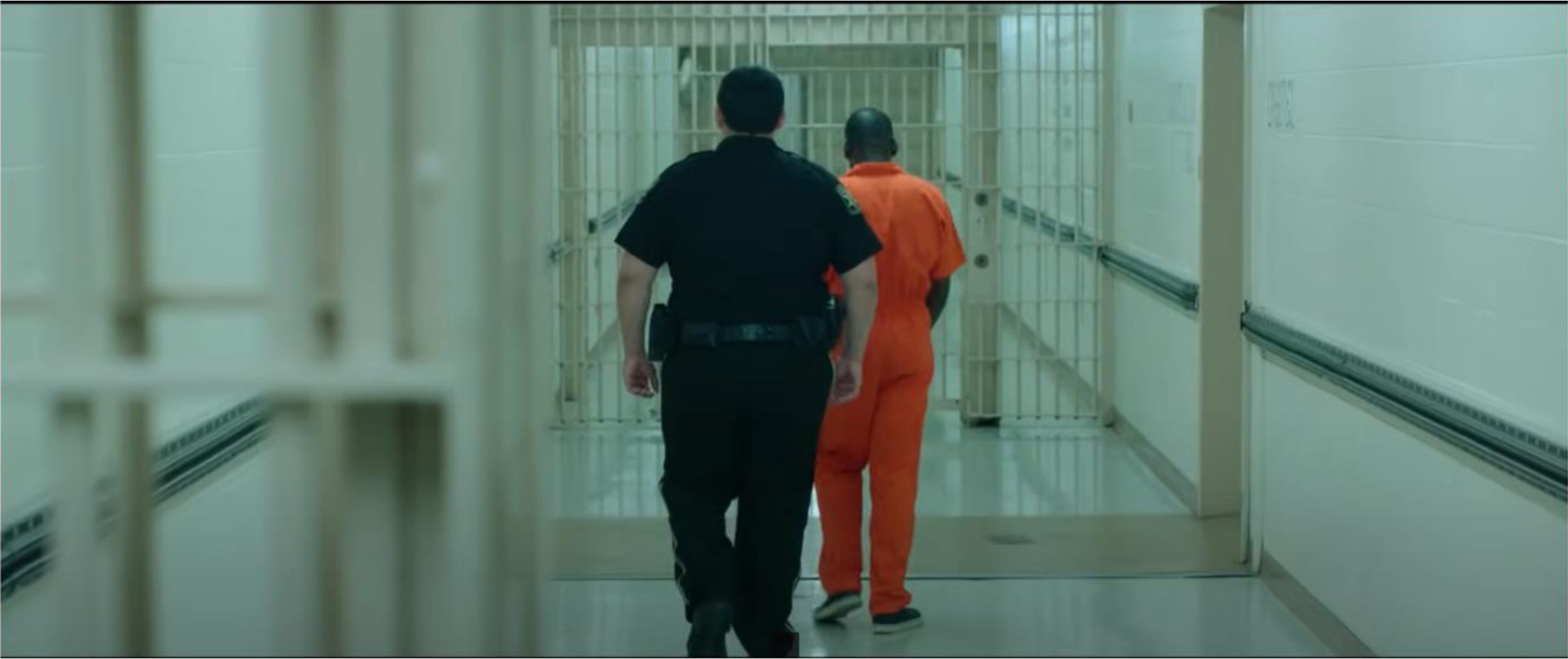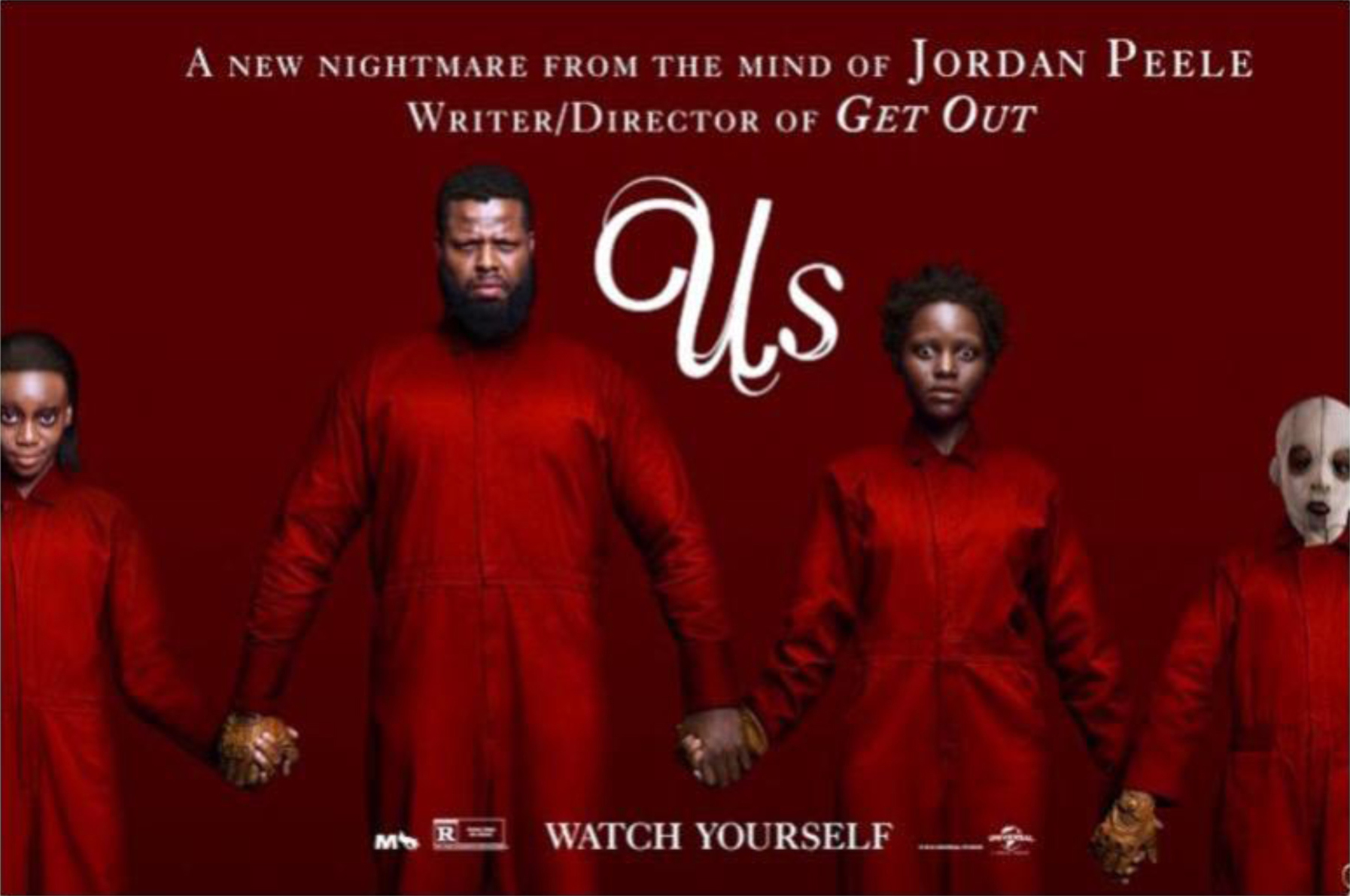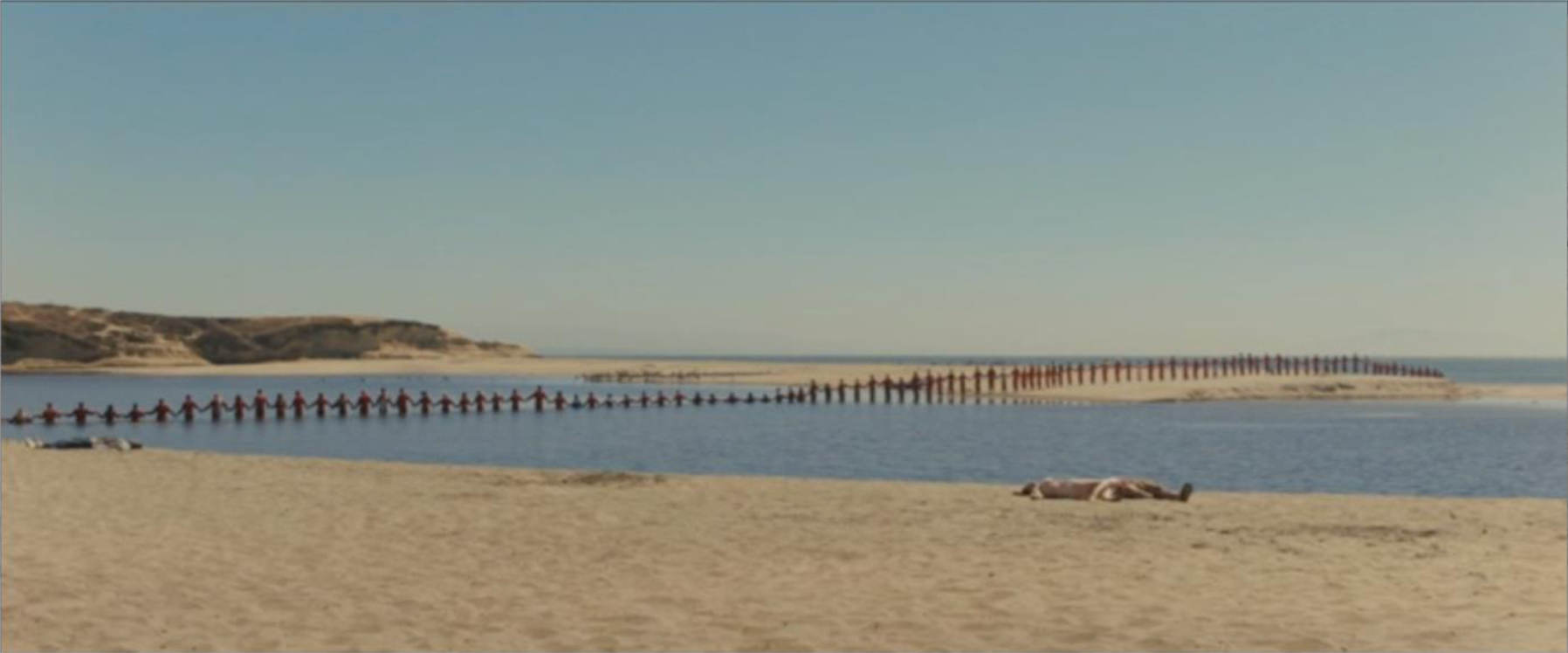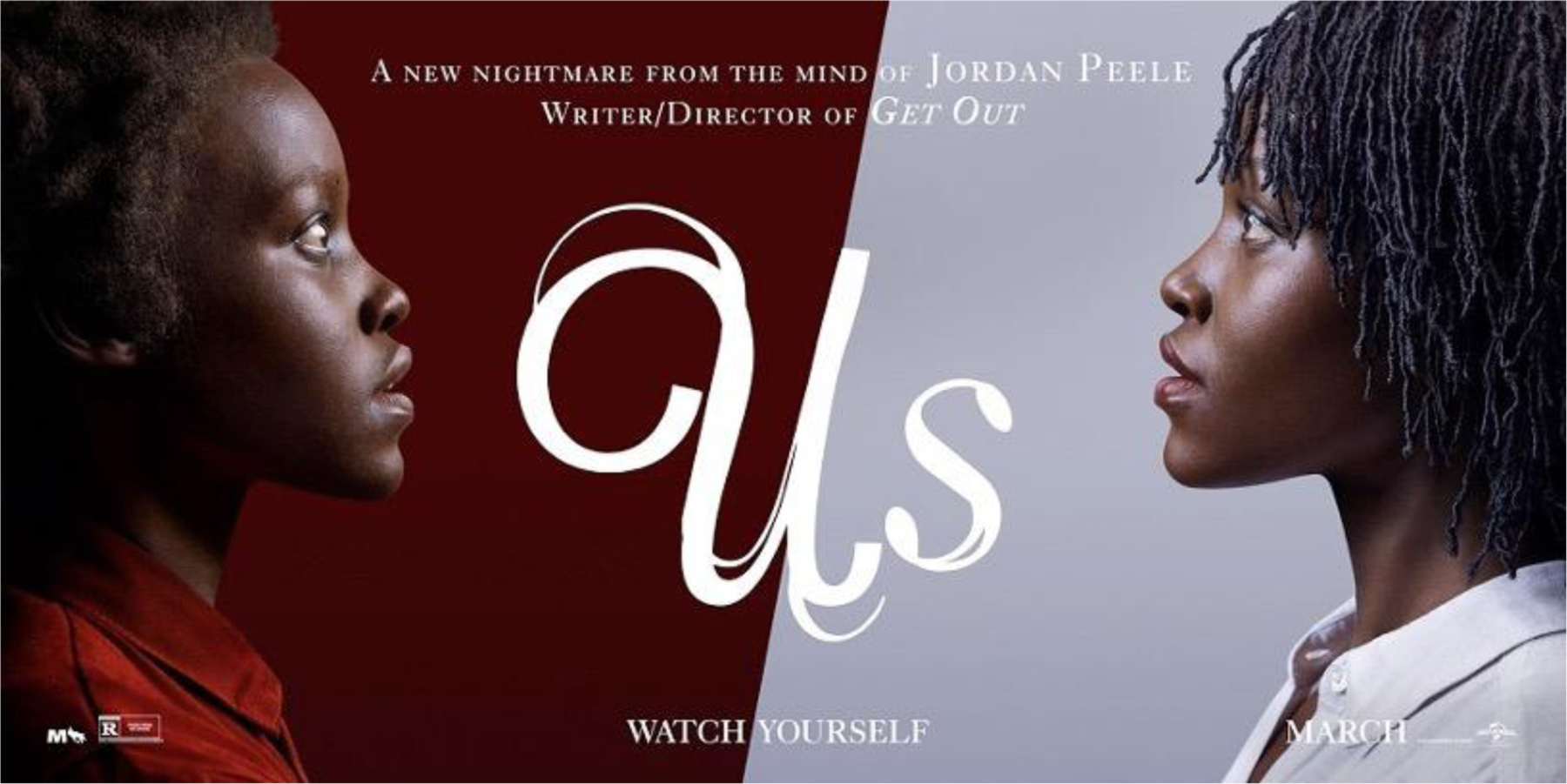In Us (2019), Jordan Peele appropriates and remobilises various visual and narrative aspects of Stanley Kubrick’s The Shining (1980). He reimagines The Shining, which is mainly about whiteness, from an African American perspective. Peele thus forms part of a movement Robin R. Means Coleman describes in Horror Noire: “Reinventing the [horror] genre from the vantage point of Blackness often mean[s] reimagining the classics” for political purposes.1 Us is a remake—most directly of a Twilight Zone episode called “Mirror Image,”2 but it also borrows from several feature films about spooky doubles, haunting, home invasion, and mass uprisings.3 Of these, it was The Shining that most influenced Peele: “I really love The Shining. You ask me any day of the week what’s my favorite horror movie and 2 out of 3 times, I’ll say The Shining.”4 There is an undeniable boldness in repurposing or remaking a cultural icon like The Shining, even by way of reverential homage. Jeremi Szaniawski acknowledges that such postmodern play by directors who come after Kubrick has “an empowering, liberating side–a sense that nothing is sacred … [Kubrick…] belongs to all of us, for better or for worse.”5 Peele is undoubtedly making himself as an auteur by remaking Kubrick, so Peele’s relationship with Kubrick is one of dependence as well as an assertion of his own imprimatur. Peele’s film is, as Us would have it, “tethered” to Kubrick’s film: remodelling it without entirely shedding its support. Us references a Biblical passage: “Therefore thus saith the Lord, Behold, I will bring evil upon them, which they shall not be able to escape; and though they shall cry unto me, I will not hearken unto them.” (Jeremiah 11:11) There are three things to note about this scriptural citation: inescapability, symmetry, and doubling. These characteristics are evident in Us and Peele’s approach to Kubrick. Peele doubles, refracts, and recasts The Shining, so that Kubrick’s film becomes an inescapable intertext for Us.
Thomas Leitch says, “Remakes seek to mediate between the contradictory claims of being just like their originals only better.”6 Peele remakes Kubrick’s film “only better” for Black audiences. This is subversive and has the potential to be liberatory from the point of view of race. In terms of class, Peele also significantly widens the lens of the allegory: from the Overlook hotel as a synecdoche of American class relations in the twentieth century, to the entire urban and ex-urban landscape of the US as a nation. I ask two questions of Us: “Does Peele put his own stamp on the material and make it his own?” And “does it represent a liberatory discourse from a social justice point of view?” The expectation that horror be progressive is possibly unreasonable, but Peele’s work with race and representation in Get Out (Jordan Peele, 2017) and Us suggests that that is on his agenda. Derek Johnson coined the term “social justice reboot.” 7 I borrow and modify it to encompass the “social justice remake.” According to Johnson, the social justice reboot, “articulates the industrial management of change with political struggles to transform exigent inequalities of representation, access and privilege within consumer society.”8 As Johnson says, intrinsic to such reworkings are both promises and threats because “the ultimate stakes are a question of who will hold, gain or lose cultural power.”9 However, there is a limit to how disruptive reboots or remakes can be to the established order:
Film reboots … allow media industries to deliver change, but in a managed way that need not fully disrupt the status quo. Reboots, in this sense, are conservative in nature, even as they might also be celebrated by activists and other forces who see them as a battleground for reimagining familiar images and narratives to be more inclusive. The social justice reboot, in this sense, reveals how the variations in successive entries in a film series…take shape in response to activist pressures (and resistance to them) – but in ways that allow industry to manage that change without disrupting existing power structures. … When conceived through the film reboot, social justice becomes a commodity to be purchased…. In this way, … social justice … [is delivered] alongside its denial 10
In many places in Us, Peele successfully remodels The Shining to serve his own vision, liberating him to represent Blackness on screen. However, the film’s effects in terms of more general liberation are equivocal when one considers class and gender. This is partly because of the off-screen intractability of the issues of race and class with which Peele deals and partly because of the tropes of gender he has inherited from the horror genre in general, and The Shining in particular. Of relevance to this discussion is Chuck Tryon’s discussion of racialized recasting in the Rocky/Creed franchise,11 which can be read, as Get Out can, against the Black Lives Matter movement. Claire Perkins’s analysis of the gender-swap remake is also useful. This can be read against the background of popular feminist movements like #Metoo and #Timesup.12 However, one area of social justice that is left conspicuously unrepresented by these scholars is class, with which I will deal.
This paper contributes to the critical discussion of Peele’s evolution as an important contemporary filmmaker in several ways. Much has been written about Get Out; much less about Us. Much has been written about Peele and race. Less has been written about Peele, class, and gender, as I propose to do. The paper also contributes to the discussion of directors who come, as Jeremi Szaniawski’s book title has it, After Kubrick. In discussing directors who come after Kubrick and emulate his filmmaking, particularly The Shining, Rick Warner formulates something he describes as “Kubrickian dread.” He focuses on the works of Jonathan Glazer. Paul Thomas Anderson, and David Lynch—all white filmmakers. In a footnote, he notes intertextualities between Peele’s Get Out (2017) and Kubrick’s The Shining and A Clockwork Orange (Stanley Kubrick, 1971), 13 but he does not expand on this insight in his text. He does not consider Us (and could not have done so, given the date of publication of the volume in which he writes). My analysis expands on Warner’s parenthetic insight to elaborate on the connections between Kubrick and Peele as horror auteurs, and extend the discussion to encompass what it means to come after Kubrick as an African American filmmaker.
Synopsis
Us begins with a childhood vignette. A little Black girl, Adelaide (Madison Curry), wanders away from her father at the Santa Cruz boardwalk and emerges traumatized from the hall of mirrors. Flashforward to an adult Adelaide (Lupita Nyong’o) and her family of four — Gabe (Winston Duke), Zora (Shahadi Wright Joseph) and Jason (Evan Alex) Wilson— going on vacation in their beach house near Santa Cruz. They meet their white friends, the Tylers (Elizabeth Moss, Tim Heidecker), who are ever so slightly better off than the Wilsons and who have twin daughters (Cali Sheldon and Noelle Sheldon). Adelaide is uneasy about returning to the scene of childhood trauma, and as it emerges, her paranoia is entirely justified. There is a violent home invasion by a family of spooky doppelgangers— Red (Lupita Nyong’o), Abraham (Winston Duke), Umbrae (Shahadi Wright Joseph) and Pluto (Evan Alex). These are the ‘tethered,’ who are, as Red explains, the Wilsons’ underprivileged counterparts from an underworld network of subterranean tunnels. A battle for survival ensues. The Wilsons run to the Tylers’ house only to discover that the Tylers, too, have their tethered. Unlike the Wilsons, the Tylers’ tethered succeed in killing them. The Tylers’ murders are played for uncomfortable laughs, while Wilsons’ home invasion immediately preceding it is played entirely for horror and suspense. The Wilsons ultimately escape their doubles, although the tethered have arisen en masse and taken over the country. And there is a twist. The child that emerged from the hall of mirrors at the beginning of the drama was not Adelaide but her tethered twin. She has been leading a stolen life ever since, passing as her more privileged double. The final frames of the film show a chain of the tethered, hands joined, stretching across the country as far as the eye can see.
Us and The Shining
Like The Shining, Us is a horror show about a family, but Peele swaps the white Torrances for the Black Wilsons. As in The Shining, horror is represented by uncanny doubles: the murdered Grady girls in The Shining, the tethered in Us. There are many mise-en-scene echoes. The butchered bodies the Tyler daughters are posed exactly like the murdered Grady twins. The network of underground tunnels in which the tethered live recalls the architecture of the Overlook. Ina Diane Archer calls this network “national ‘sunken place,’” alluding to Peele’s previous film Get Out.14 But as Elaine Roth points out, in Get Out, the sunken place “registers as an excavation of Black power for white benefit, whereby Black bodies are subsumed and consumed for white pleasure while ... Black identities are silenced and sidelined.”15 However, Red and her family are, like the Wilsons, Black. What distinguishes them is not race but class. Where the Wilsons have enjoyed relative privilege, their doubles have lived half-lives of compulsion rather than choice. Even their bodies are not their own,16 as is demonstrated when Jason methodically walks Pluto into a fire that kills him. Us is about a relationship of slavery beyond race, but not beyond class.
Seeing double
Watching Us involves rewatching The Shining, but as if seeing double. Seeing and not seeing are at the heart of The Shining and Us. Danny (Danny Lloyd) can see more than he should by virtue of the shining. The first time we are introduced to this capacity, he is standing on a step stool in front of the bathroom mirror, looking at his reflection but talking to Tony, the little boy who lives in his mouth. Danny asks Tony about the Overlook Hotel. Tony, reluctantly, shows him visions of elevators disgorging blood, of twins. The blood engulfs the camera, and the screen goes black. Danny is overwhelmed by these visions and passes out. On waking, he refuses to talk about what he has seen. In the case of the young Adelaide, her first trauma occurs in the mirror maze, which recalls Danny’s mirror and the maze outside the Overlook in The Shining. She enters this structure under a sign that says “Vision Quest: find yourself.” As she goes deeper into the maze, it becomes darker—so dark we can hardly make her out but for her white collar. She becomes frightened and disorientated. She backs up to a mirror. She whistles to reassure herself and tries again, more calmly, to explore the space. There is an answering whistle—not quite an echo. She backs up to another mirror. Although we see a little girl just like her, the reflection does not move with her. As strings reminiscent of The Shining gather to a crescendo on the soundtrack, she turns and faces the back of the reflection’s head—an impossible image. This is, of course, a precursor to her being abducted into Red’s underworld, after which Red swaps places with her, and passes for Adelaide in the world above.
In The Shining and Us, Danny and Adelaide are children who see too much, who know too much. They become “uncanny” children who mediate between worlds.17 Danny is often seen as losing his innocence in The Shining, but Danny never was an innocent, thanks to his history of abuse at Jack’s (Jack Nicholson) hands and thanks to the shining. Danny’s knowing extends to his capacity to divine and screen his father Jack’s worst impulses for the extra-diegetic audience. It is through Danny’s consciousness that Jack’s encounter with the hag in the bath in room 237 is filtered, after all. The shining also allows Danny to mediate temporally between past, present and future and between races to commune with Hallorann (Scatman Crothers). Young Adelaide, who becomes Red, first sees her impossible reflection, and then comes to know about the occult underworld of the tethered, of which her parents are oblivious. Where Danny sees all in the mirror, including future violence, Adelaide is confronted with the blind spot her position of class privilege involves. 18 Alison Lansberg describes Peele’s practice as “horror verité,” discussing “certain cinematic conventions of the horror film – a specific set of formal and narrative strategies – [that] are uniquely suited to render everyday, endemic and chronic horror – a horror that many in US society do not, or perhaps more accurately refuse, to see.”19 In the case of the Wilson family at the heart of Us, the horror they do not see is the underprivilege their position of privilege assumes. In remodelling these encounters between children and their mirror images, Us repurposes The Shining’s motifs of seeing to render the unseen horror of US society visible. Danny’s and Adelaide’s visions expose systems of power that govern their parents’ worlds: structured by patriarchal and genocidal violence in The Shining, structured by class in Us, structured by race in both.
Remaking, race, class, and gender
Means Coleman distinguishes between “Blacks in horror films” and “Black horror films,” with the latter situating themselves amid African American life and having Black audiences more clearly in mind. 20 Hallorann’s role in The Shining is as a “Black in a horror film,” whereas Get Out and Us are Black horror films. Means Coleman has commented on Hallorann: “The Shining ... is especially powerful in its ... approach to the symbolic annihilation of Blacks. ... [in] the self-sacrificing Black character—a character who dies in the course of saving Whiteness.”21 This reading confirms the oft-rehearsed trope that the Black protagonist is the first to die in a horror film, but as The Shining is a parody of horror conventions,22 this may be a case of Kubrick pandering to tropes to subvert them. After all, Jack Torrance’s murder of Hallorann is a deliberate and shocking reversal of expectations in relation to Stephen King’s novel.23 The whiteness in question is critically framed. However, Peele explicitly went against the trope of killing off the Black character in allowing Chris (Daniel Kaluuya) to survive Get Out. Similarly, the Wilsons survive Us, although there are important inflections on that film’s conclusion, as I will discuss below. Peele discusses his ideas for the Wilson family thus:
I can’t think of a horror movie of this nature with a family in the center of it that uses a Black family. So I knew just by putting an African-American family in the lead role, already we would be exploring cinematic uncharted territory ... I love The Shining …[but] I felt like it was an important piece of the project to have a Black family in the center.24
This is an explicit response to Hollywood whiteness: “I don’t see myself casting a white dude as the lead in my movie. Not that I don’t like white dudes, […b]ut I’ve seen that movie.” 25 Peele is thus repurposing Kubrick’s The Shining to achieve Black representation and for black audiences. In this, he is assertively going beyond what Ryan Coogler did in Creed (2015), which, as Tryon characterises as “gently [subversive]” of Rocky’s (1976) racial politics.26 Replacing the white Torrances with the Black Wilsons may seem to qualify Us as a “social justice” remake. However, Black representation is not enough to achieve social justice, because the tethered “them,” who are also “us” are not racially distinguished from the Wilsons, and monstrosity is not safely “othered.” Indeed, “they” are “us.” Us may be made for Black audiences, but it also warns spectators who may identify with the Wilsons about the dangers of wanting what Omotayo O. Banjo calls “white shit:” the consumer culture of middle-class whiteness,27 and of becoming too complacent about their own privilege. Even from the point of view of race, the status of Us as a liberatory discourse is problematic. The extra-diegetic power of the Capitalist economy in which Us is made and consumed prevents easy identification with the Wilsons, the Tylers, or the tethered. But as Johnson points out, social issues may be rehearsed and problematised precisely to contain or deny them. Us is, after all, a marketable media produced, so that social justice becomes a “manageable media commodity.”28 The social critique mobilised by Us cannot escape the imbrication of the film in a Capitalist economy.
When it comes to the underclass, other issues emerge. The tethered are dressed uniformly in red boiler suits, suggesting leftist collectivism: they are Capitalism’s others. They are characterised as monstrous; they are terrors. Further, they reach beyond the Wilson household to engulf the country. Red’s uprising literalizes the logline for The Shining, which was billed in terms of the “tide of terror that swept America.” This has been read as terror of the white man by those who fix on the film’s intimations of genocide.29 However, racial annihilation is instantiated chiefly in Hallorann’s almost incidental murder. The Shining’s critique of patriarchal violence is more pressing, particularly where that violence is “justified” in terms of capitalist enterprise or class-based resentment. One of Jack Torrance’s most menacing scenes comes when he backs Wendy (Shelley Duvall) up the stairs, threatening to murder her because her plan to leave the Overlook will interfere with his capacity to fulfil his contractual obligations to his employers. The presence of Grady as a family-murdering patriarch suggests that the menace Jack represents may be more widespread, but in The Shining, the drama focuses tightly on the Torrances Kevin J. Wetmore. discusses The Shining, drawing a contrast between its localised terrors and a more generalised fear in recent horror films: “The haunting of a remote hotel is terrifying enough in The Shining, [but] after 9/11… films manifest a fear of a changed world: one in which ‘we’ are no longer in control and in which ‘they’ dominate.”30 When asked by Adelaide who she is, her double Red says, “We’re Americans.” The title Us suggests not only “us” vs “them,” but all of the US. The generalizability of the problem the tethered represent is indicated by visual echoes of The Shining. After the Us cuts from Adelaide’s eyes, wide in terror, in the hall of mirrors sequence, it cuts to an image of a white rabbit. The shot zooms backwards to reveal a wall of rabbits in cages. This zoom mirrors and reverses the sequence that reveals the wall of photos in which Jack is finally enshrined in the closing moments of The Shining. Where the final gesture of The Shining is to zoom in on Jack, the opening gesture of Us is to zoom out. One bunny represents many. Red represents legions. While Jack ramifies through time back to 1924, he is contained spatially within the Overlook. The tethered, however, ramify spatially across the entire country.
Todd McGowan says that the tracking shot leads Us out from the horror genre’s, and The Shining’s, “myopic” focus on the nuclear family towards a focus on the collective. In its broader critique of class society, he finds that Us carves new generic pathways for the horror genre.31 He says that the Wilson family’s fate ceases to matter in the context of Red’s revolt, which he appears to valorise. However, I am not so sure Peele either forgets about the Wilson family, or valorises the tethered. One of the things that McGowan seems to overlook is precisely the point that the tethered are horrific. Similarly, Brady Simenson asserts that Red is shot for empathy, vulnerability, and humanity, which seems an extraordinary claim.32 In terms of class, the social justice credentials of Us are more equivocal than McGowan and Simenson allow, and the film’s ending can be read pessimistically. The Wilsons may appear to escape, (although they are bringing a member of the tethered with them), but the nation has not.
In this closure, Peele follows Kubrick in another way. He evokes Warner’s “Kubrickian dread,” which “shades into the looming extinction of humanity as a whole.”33 This is what the US is confronting in Us. As spectators, we are “handed over to nonhuman agencies that are radically unknowable and insuperable.”34 The tethered surely qualify as barely human agents (that is the point) who are insuperable, if not unknowable. Warner says of contemporary auteurs who follow The Shining that their “works renounce closure [so that the t]he lack of finality lets atmospheric dread and suspense grip us more lastingly, leaving us addled and reduced, but also energized for a future replay of this very experience.”35 Kubrickian dread “partake[s] in the first movement of the sublime [, inducing terror, ] without giving us the subsequent uplift of regained superiority over our environment.”36 As Jason’s final exchange of gaze with Adelaide indicates, the tethered have infiltrated the family, and Jason may be aware of that fact. It is as if Danny and Wendy brought Jack along in their escape from the Overlook. The tethered are truly inescapable either in the family, or in the nation.
In this swapping Adelaide for Jack as the monster in the family, Us marks a reversal of the gender politics of The Shining. Perkins says that “the mere fact of the gender swap promises [a] ‘true’ reboot insofar as it implies a new, revisionist perspective from which the story could be told.”37 And Peele may achieve that, to a degree. In Film Comment, Ina Diane Archer says that “Peele’s highlighting of girls and women as leaders instead of victims is bracing.”38 Adelaide might be considered a “final girl,” 39 and therefore valorised. However, final girls are almost invariably white, and they defeat the monster. Adelaide, by contrast, becomes the monster. Red, and the Adelaide with whom Jason shares the final exchange of gaze, are closer to Barbara Creed’s monstrous mother.40 Where Tryon argues that Coogler manages to maintain nostalgia for Rocky while updating the gender politics of Creed,41 Peele’s reworking Kubrick’s The Shining may have led him up a misogynistic path. The result of doubling Adelaide/Red and “gender-swapping” her for Jack is, at best equivocal from a social justice point of view.
But there is another model of horror femininity to consider. Means Coleman writes:
Black women are not going up against some boogeyman; rather, often their battle is with racism and corruption. In this regard, there is no going to sleep once the “monster” is defeated, as the monster is often amorphously coded as “Whitey,” and Whitey’s oppressions are here to stay. ... Black women in horror films could be described as resilient “Enduring Women.” They are soldiers in ongoing battles of discrimination, in which a total victory is elusive. The Black woman’s triumphant walk into the sunset promises to take her, not toward a life of peace, but back into the midst of rogue police, sexist men, and “the Man.”
The Wilsons may be escaping to Canada or Mexico, but it is unclear whether the tethered know geopolitical boundaries. If they are not heading into the midst of whiteness, they are heading into the midst of something. Total victory is elusive, but for different reasons than those Means Coleman lays out. In this case, it is because Adelaide herself is one of the monsters. Where The Shining dramatized monstrous masculinity, Get Out and Us dramatize monstrous femininity. Where Jack and Grady are doubled as monstrous fathers in The Shining, Adelaide and Red are doubled as monstrous mothers in Us. Adelaide is at once final girl, enduring woman, and monster. In this, Peele does not exceed horror genre tropes that cast women as monsters, but perhaps, like Kubrick, he is parodying them.
Performance
In comparing Us with The Shining, there is, of course, the question comparing performances by Lupita Nyong’o and Jack Nicholson. Jack Nicholson unnerved Kubrick’s audiences with his “grotesque” antics,42 the grotesque being “a mode of expression that sharply exaggerates physical and emotional traits, mixes conflicting tones, partakes of cynicism, brings the fantastic into play while keeping a foot in realism, and revels in unresolved ambiguity, irony, and paradox.”43 Warner describes the “agile conjunctions of horror and comedy” that typify such performances.44 As Red, Lupita Nyong’o terrifies diegetic and extra-diegetic audiences in Us. Peter Bradshaw says that Nyong’o brings to the role “a basilisk stare of horror.”45 Many remark on her voice: the kind of voice that comes from a crushed larynx.46 David Edelstein describes it as “the whistle of someone whose throat has been cut, with a gap between the start of a word in the diaphragm and its finish in the head [;] it’s like a rush of acrid air from a tomb.”47 Justin Chang says it “sounds like the voice of someone whose lungs have been crushed underfoot, who hasn’t been able to breathe for years.”48 But most extraordinary is her kinetic acting—at once jagged and balletic. It echoes the undead choreography of Michael Jackson’s “Thriller” music video, which is referenced through young Adelaide’s T-shirt.49 Marionette-like, her movements represent the puppetry that Red’s life of compulsion has involved vis à vis Adelaide: Red’s is a black body that has not been her own.50 Hannah Giogis says of Nyongo’s performance that it
anchors the film. Rather than playing one character who devolves into villainy, as the actor Jack Nicholson did in his thrilling embodiment of The Shining’s Jack Torrance, Nyong’o presents two distinct characters whose moral trajectories rely on each other. The work here is daunting: Red and Adelaide share a rich, painful history, but Nyong’o must stretch them away from each other and fill the ensuing gap from both directions. ... As Red and Adelaide, then, Nyong’o telegraphs this morbid domination and irrevocable codependence.51
Arguably, then, Nyong’o had a more complex task than Nicholson in playing both Adelaide and Red and at least comes close to matching his performance. In casting and directing Nyong’o, Peele makes Us a fresh new entry in the horror canon. He makes it his own.
Atmosphere
The climax of the suspense in Us is a pas de deux between the teenager Red and Adelaide (Ashley McCoy), which is intercut with the final confrontation between their adult counterparts. In this sequence, Peele effectively evokes Warner’s “Kubrickian dread,” in that “atmospheric suspense ... thickens insofar as the precise relations between music, character behavior, and environment evade us.”52 On the soundtrack, an atonal choral theme intensifies as Red explains the tethereds’ origins and her role in the uprising: she and Adelaide are both “special.” Teen Red and Adelaide perform their dances—Adelaide’s graceful and Red’s angular and muscular. Drums and strings intensify. The music becomes an orchestral arrangement of the title track, “I got 5 on it,” which features a low, throbbing beat. As the adults’ fight intensifies, the orchestration’s bassline thickens. A crescendo builds to the point where Adelaide finally skewers Red on a poker. Then all extradiegetic sound abruptly ceases, leaving only the diegetic sounds of the struggle. The dying Red whistles a parody of the tune young Adelaide whistled to reassure herself in the hall of mirrors. Adelaide brutally strangles her. A low orchestral hum arises as Adelaide searches for and finds Jason. Uneasy instrumentation injects doubt into the reassurance she seems to offer before it resolves as the family reunites and drives away. In his atmospheric synthesis of performance and music in the pas de deux/duel scene, repurposes Kubrickian motifs, images, and ideas to suit his own vision.
Peele’s filmography
It is important to understand where Us falls in Peele’s filmography: after Get Out and before Candyman (Nia Da Costa, 2021), on which Peele worked as screenwriter and producer. In Get Out, Peele deals with the “absurdity of the idea of race”53 and demonstrates the problem of imagining liberation. Peele shot two endings. In the original ending, the black protagonist Chris strangles his monstrous white girlfriend, Rose (Allison William), to death. A police cruiser approaches. Chris is incarcerated. Of this ending, Peele said that he wrote it to reveal the “post-racial lie” inaugurated by the Obama presidency. The Black man might escape the white house of horrors, but he couldn’t escape the larger structures of racism in the United States. As Ryan Poll points out, the original ending for Get Out posited that horror for Black audiences extends beyond the cinematic screen. Poll says: “to be Black in America ... is to be trapped within an unending narrative of racialized terror. For African Americans, horror is not a genre, but a structuring paradigm.”54 The Black man can never get out. By the time Peele came to finalise the film, however, Obama was out of office, and he felt people needed a hero. In the theatrical ending, Chris recovers his relents before killing Rose, and Chris’s friend Rod (Lil Red Howery) arrives to rescue him. By contrast with this happy ending, Us does not necessarily offer magical solutions on-screen to issues that so insistently persist off-screen for the extra-diegetic audience, particularly the structuring inequalities of class. Us takes up where the original ending of Get Out left off: with the return of the oppressed, in carceral attire, to take revenge on the free. As discussed, they eventually conquer the US “from sea to shining sea.” The inescapability of race and class inequality insist themselves.
Candyman, like Us, is a remake of a white director’s work (Candyman, Bernard Rose, 1992), which was itself an adaptation of white author Clive Barker’s “The Forbidden,” a short story about class.55 Da Costa’s Candyman starts by acknowledging its predecessor through a shadow puppet dumb show. Like Peele’s Us, it is reverential in its homage to canonical entries in the horror genre but refracts and repurposes them through a Black lens. Instead of the white female middle-class graduate student, Helen Lyle (Virginia Madsen), studying the projects, we have the Black male middle-class artist, Anthony McCoy (Yahya Abdul-Mateen II), looking for material for his art, which represents Black oppression. He is explicitly interrogated about the effects of his middle-class aspirations: the gentrification of the project to make way for his comfortable modern apartment block is critiqued. But where Rose’s Candyman was a monster who ended up causing the death of the white protagonist, Da Costa’s Candyman figures the Black Candyman as a saviour. The film ends with a Black woman, Brianna Cartwright (Teyonah Parris) invoking a Black supernatural being to escape a white policeman. This is remaking as literal liberation from racially oppressive forces. Its social justice aspirations are underscored by its marketing via a website entitled the “Social Impact Initiative.” This features panel interviews in which “experts discuss how Candyman goes beyond trauma to celebrate the resiliency and creativity of Black culture.”56 And possibly because Candyman was directed by a woman, it escapes some of the horror genre misogyny of Get Out and Us. Comparing Candyman with Us reveals what is possible if the aspiration is the social justice remake.
Conclusion
Herbert observes, “remakes ... are big business. But they are also big culture.”57 Peele approaches the white auteurs he remakes by appropriating their ideas, images and tropes by homage and remodelling them politically. I have traced some of the ways Peele repurposes Kubrick’s The Shining, reading them through a lens that connects remaking with race, class, and gender. While, to some extent, remaking enables Peele as a filmmaker to make social justice interventions regarding Blackness, but his interventions on class and gender are less easily categorised as progressive.
My first question was, “does Peele make this film his own?” My answer is yes, and this can be seen by contrasting Us with the efforts of another filmmaker who had remade The Shining before him: Mike Flanagan, who made Doctor Sleep in 2019. This film returned its audience to the slavishly reconstructed mise-en-scene of Kubrick’s Overlook in its final third, and which inverts the gender politics of Kubrick’s film. I have previously found that remake wanting because Flanagan falls between two stools in trying to serve two masters: both the sentimental Stephen King and the more cynical Kubrick.58 Being overmastered by Kubrick, as Flanagan was, is not an accusation that can be levelled at Peele because of the ways he made Us his own through wise casting and skilled direction, among other things. Monica Castillo says:
Jordan Peele isn’t the next Kubrick, M. Night Shyamalan, Alfred Hitchcock or Steven Spielberg. He’s his own director, with a vision that melds comedy, horror and social commentary. And he has a visual style that’s luminous, playful and delightfully unnerving. Peele uses an alternate cinematic language to Kubrick, seems more comfortable at teasing his story’s twists throughout the narrative unlike Shyamalan, uses suspense differently than Hitchcock, and possesses the comedic timing Spielberg never had. Us is another thrilling exploration of the past and oppression [America] is still too afraid to bring up.59
In terms of Us as an exploration of the past and oppression America is still too afraid to bring up, my second question was, “is this a more generally liberatory discourse?” While Peele succeeds in repurposing Kubrick’s drama about whiteness for Black audiences, my answer is that it is not, ultimately liberatory in terms of class and gender. The conclusion of Us sees Red and the untethered triumph, but that triumph is figured horrifically. Further, Peele reimagines Kubrick at the expense of casting women as monsters—the “them” in Means Coleman’s analysis of horror tropes. She is talking about race, but I think this could as well be applied to gender:
One thing that is clear is how difficult it is to create representations that break free from the steady diet of confining depictions image-makers have already been fed. Horror continues to propagate an “us,” “them,” and “us versus them” understanding of race relationships…As a result, horror is, at times, overly segregated or too much of just “us.” Non-Black horror has been particularly difficult on this point, uncomfortably excluding Blacks, and all manner of gender, sexuality, and racial diversity. The response to such exclusion has been the production of still more “us” horror films.60
Arguably, Peele’s “us” may be male, as well as Black, and he does not escape Kubrick’s, and horror’s, misogynistic thrall.
But Us is such a richly evocative text that it invites as many interpretations as The Shining.61 As rewatching The Shining yields fodder for both legitimate and crackpot readings,62 so will rewatching Us. In this article, I have rewatched The Shining through the lens of Us and Us through the lens of The Shining, and the process has remade me. As Dennis Cutchins and Kathryn Meeks point out, we in the audience remake ourselves every time we consume an adaptation or a remake in a continuous process of “self-creation”.63 The audience for Us, the extradiegetic “us” to whom the title appeals, are remaking our understanding of The Shining by watching Peele’s film. The logline for Us invites the spectator to “Watch yourself.” We are invited to watch and rewatch our self-construction as raced, classed, and gendered consumers of cinema.
Author Biography
Joy McEntee SFHEA is a Senior Lecturer in the Department of English, Creative Writing and Film. She focuses on American film, especially Stanley Kubrick, and literature-to-film adaptation. Her work has appeared in The Bloomsbury Companion to Stanley Kubrick, Camera Obscura, Screening the Past, Senses of Cinema, Film Criticism, Adaptation, and Literature/Film Quarterly. She is currently writing a monograph on women in Kubrick’s cinema for Liverpool University Press.
Notes
- Robin R. Means Coleman, Horror Noire: Blacks in American Horror Films from the 1890s to Present (New York and London: Routledge, 2011), N. Pag. ⮭
- Matthew Rozsa, “Jordan Peele’s Creepy, Disturbing “Us” Gives a “Twilight Zone” Classic a Sharp Edge,” Salon, March 22, 2019 https://www.salon.com/2019/03/22/jordan-peeles-creepy-disturbing-us-gives-a-twilight-zone-classic-a-sharp-edge/. ⮭
- Peele’s homework for the cast included The Shining, The Birds (Alfred Hitchcock, 1963), Dead Again (Kenneth Branagh, 1991), Funny Games (Michael Haneke, 1997) or Funny Games US (Michael Haneke, 2007), The Sixth Sense (M. Night Shyamalan, 1999), A Tale of Two Sisters (Kim Jee-woon, 2003), Let the Right One In (Tomas Alfredson, 2008), Martyrs (Pascal Laugier, 2008), The Babadook (Jennifer Kent, 2014) and It Follows (David Robert Mitchell, 2014), with which Us shares cinematographer Mike Gioulakis (his signature circling camerawork can be seen in the home invasion scene). Petey Oneto, “Examining Jordan Peele’s Us Homework,” IGN, March 21, 2019 https://www.ign.com/articles/2019/03/20/examining-jordan-peeles-us-homework. ⮭
- Trey Mangum, “With ‘Us,’ Jordan Peele Has Crafted the Next Iconic Horror Classic [Spoiler-Free],” Shadow and Act, March 11, 2019 https://shadowandact.com/with-us-jordan-peele-has-crafted-the-next-iconic-horror-classic-spoiler-free. ⮭
- Jeremi Szaniawski, “Introduction,” in After Kubrick: A Filmmaker’s Legacy, Jeremi Szaniawski (New York and London: Bloomsbury, 2019), 48. ⮭
- Thomas Leitch, “Twice-Told Tales: The Disavowal and Rhetoric of the Remake,” in Dead Ringers: The Remake in Theory and Practice, edited by Jennifer Forrest and Leonard R. Koos (Albany, NY: State University of New York, 2001), 45. ⮭
- Derek Johnson, “Resistance and Empire: Star Wars and the Social Justice Reboot,” in Film Reboots, edited by Daniel Herbert and Constantine Verevis (Edinburgh: Edinburgh University Press, 2020), N. Pag. ⮭
- Johnson, “Resistance,” N. Pag. ⮭
- Johnson, “Resistance,” N. Pag. ⮭
- Johnson, “Resistance,” N. Pag. ⮭
- Chuck Tryon, “Rebooting the Politics of the Sports Melodrama: Creed vs Rocky,” in Film Reboots, edited by Daniel Herbert and Constantine Verevis (Edinburgh: Edinburgh University Press, 2020), N. Pag. ⮭
- Claire Perkins, “Ghost Girls: Ghostbusters, Popular Feminism and the Gender-Swap Reboot,” in Film Reboots, edited by Daniel Herbert and Constantine Verevis (Edinburgh: Edinburgh University Press, 2020), N. Pag. ⮭
- Rick Warner, “Kubrickian Dread: Echoes of 2001 a Space Odyssey and The Shining in Works by Jonathan Glazer, Paul Thomas Anderson, and David Lynch,” in After Kubrick: A Filmmaker’s Legacy, edited by Jeremi Szaniawksi (New York: Bloomsbury, 2019), 221. ⮭
- Ina Diane Archer, “Review: Us,” Film Comment, March 26, 2019, https://www.filmcomment.com/blog/review-us/. ⮭
- Elaine Roth, “This Is America: Race, Gender and the Gothic in Get out (2017),” in Gothic Film: An Edinburgh Companion, edited by Richard J. Hand and Jay McRoy (Edinburgh: Edinburgh University Press, 2020), N. Pag. ⮭
- Dawn Keetley, “Get Out: Political Horror,” in Jordan Peele’s Get Out: Political Horror, edited by Dawn Keetley (Columbus: Ohio State University Press, 2020), 5. ⮭
- Jessica Balanzategui, The Uncanny Child in Transnational Cinema: Ghosts of Futurity at the Turn of the Twenty-First Century (Amsterdam: Amsterdam University Press, 2018); Jessica Balanzategui, “The Shining’s Uncanny Children and the Conflicted Nostalgia of Doctor Sleep.” Senses of Cinema, no. 95, 2020, https://www.sensesofcinema.com/2020/the-shining-at-40/uncanny-children-nostalgia-in-doctor-sleep/; Debbie Olson and Andrew Scahill, editors. Lost and Othered Children in Contemporary Cinema (Lanham and Plymouth, UK: Lexington Books, 2012). ⮭
- Todd McGowan, “Two Forms of Fetishism: From the Commodity to Revolution in Us.” Galactica Media: Journal of Media Studies .1 (2019): 8. ⮭
- Alison Landsberg, “Horror Verité: Politics and History in Jordan Peele’s Get Out (2017),” Continuum 32.5 (2018): 630. ⮭
- Omotayo O. Banjo also defines the “black context” film. Omotayo O. Banjo, “The Paradox of Post-Racialism: Black Hollywood’s Voice in Post-Racial Discourse,” in The Myth of Colorblindness: Race and Ethnicity in American Cinema, edited by Sarah E. Turner and Sarah Nilsen (Switzerland: Palgrave Macmillan, 2019), 89–112. ⮭
- Means Coleman, Horror Noire, N. Pag. ⮭
- Joy McEntee, “Paternal Responsibility and Bad Conscience in Adaptations of The Shining,” Journal of Adaptation in Film and Performance 9.2 (2016): 181–182. ⮭
- Stephen King, The Shining (London: Hodder and Stoughton, 1977). ⮭
- Jordan Peele, interviewed by Piya Singha-Roy, “Jordan Peele Breaks Down the Frightening First Us Trailer,” Entertainment, December 25, 2018 https://ew.com/trailers/2018/12/25/us-movie-trailer-jordan-peele/ ⮭
- Chris Gardner and Seth Abramovitch, “Jordan Peele on Making Movies after ‘Us’: ‘I Don’t See Myself Casting a White Dude as the Lead,’” The Hollywood Reporter. March 26, 2019 https://www.hollywoodreporter.com/news/general-news/jordan-peele-says-i-dont-see-myself-casting-a-white-dude-as-lead-us-1197021/. ⮭
- Tryon, “Rebooting,” N. Pag. ⮭
- Banjo, “Paradox,” 99–101. ⮭
- Johnson, “Resistance,” N. Pag. ⮭
- Geoffrey Cocks, The Wolf at the Door: Stanley Kubrick, History and the Holocaust (New York: Peter Lang, 2004); Geoffrey Cocks, “A Quality of Obsession Considerably Further East: The Holocaust in the Cinema of Stanley Kubrick,” Shofar: An Interdisciplinary Journal of Jewish Studies 28.4 (2010): 72–85. ⮭
- Kevin J. Wetmore, Post-9/11 Horror in American Cinema (London and New York: Bloomsbury, 2012), N. Pag. ⮭
- McGowan, “Two Forms,” 66–67. See also Russell Meeuf, White Terror: The Horror Film from Obama to Trump (Bloomington, Indiana: Indiana University Press, 2022) 61. ⮭
- Brady Simenson, “Get Out (2017), Us (2019), and Jordan Peele’s New Black Body Horror.” MA, Northern Illinois University, 2020 (ProQuest 27831881), 24–25. ⮭
- Warner, “Kubrickian,” 220. ⮭
- Warner, “Kubrickian,” 220. ⮭
- Warner, “Kubrickian,” 220. ⮭
- Warner, “Kubrickian,” 216. ⮭
- Perkins, “Ghost Girls,” N. Pag. ⮭
- Archer, “Review: Us.” ⮭
- Carol J. Clover. Men, Women, and Chainsaws: Gender in the Modern Horror Film. (Princeton, New Jersey: Princeton UP, 1992). ⮭
- Barbara Creed, The Monstrous-Feminine: Film, Feminism and Psychoanalysis. (Abingdon, Oxon: Routledge, 1993). ⮭
- Tryon, “Rebooting,” N. Pag. ⮭
- Warner, “Kubrickian,” 210. ⮭
- Warner, “Kubrickian,” 210. ⮭
- Warner, “Kubrickian,” 210. ⮭
- Peter Bradshaw, “Us Review – Jordan Peele’s Brash and Brilliant Beach Holiday Horror,” The Guardian. March 12, 2019 https://www.theguardian.com/film/2019/mar/11/us-review-jordan-peeles-brash-and-brilliant-beach-holiday-horror. ⮭
- The actress modelled this voice on a disorder arising from trauma, which has attracted the ire of disability advocacy groups. See Suzy Weiss, “Why Lupita Nyong’o’s Creepy ‘Us’ Voice Is Inciting Online Outrage,” New York Post, March 25, 2019 https://nypost.com/2019/03/25/why-lupita-nyongos-creepy-us-voice-is-inciting-online-outrage/. ⮭
- David Edelstein, “Us Doesn’t Live up to Get Out, But It Shows the Promise of Jordan Peele,” Vulture. March 22, 2019 https://www.vulture.com/2019/03/jordan-peeles-us-movie-review.html. ⮭
- Justin Chang, “Review: The Evil Is ‘Us’ in Jordan Peele’s Smart, Relentlessly Scary Follow-up to ‘Get Out.” Los Angeles Times, March 9, 2019. https://www.latimes.com/entertainment/movies/la-et-mn-us-review-20190309-story.html. ⮭
- Michael Jackson, “Thriller,” https://www.youtube.com/watch?v=sOnqjkJTMaA ⮭
- Simenson, 21. ⮭
- Hannah Giorgis, “The Kinetic Horror of Lupita Nyong’o’s Us Performance,” The Atlantic, March 27, 2019 https://www.theatlantic.com/entertainment/archive/2019/03/lupita-nyongo-in-jordan-peeles-us-terrifying/585649/. ⮭
- Warner, “Kubrickian,” 210. ⮭
- Jordan Peele, interviewed by Steve Rose, “Jordan Peele on Us: ‘This Is a Very Different Movie from Get Out,’” The Guardian. March 2, 2019 https://www.theguardian.com/film/2019/mar/09/jordan-peele-on-us-this-is-a-very-different-movie-from-get-out ⮭
- Ryan Poll, “Can One ‘Get Out?’ The Aesthetics of Afro-Pessimism,” The Journal of the Midwest Modern Language Association 51.2 (2018): 69–70. ⮭
- Clive Barker, “The Forbidden,” in Books of Blood Volume 5 (London: Sphere, 1985), N. Pag. ⮭
- “Social Impact Initiative: Candyman; The Impact of Black Horror,” https://www.candymanmovie.com/impact/ ⮭
- Daniel Herbert, Film Remakes and Franchises (New Brunswick: Rutgers University Press, 2017), 19. ⮭
- Joy McEntee, “Hijacking the Shining: Doctor Sleep.” Senses of Cinema, . 95 (2020) http://sensesofcinema.com/2020/the-shining-at-40/doctor-sleep-hijacking-the-shining/. ⮭
- Monica Castillo, “Us,” RogerEbert.com, March 20, 2019 https://www.rogerebert.com/reviews/us-2019. ⮭
- Means Coleman, Horror Noire, N. Pag. ⮭
- Castillo, “Us.” ⮭
- Daniel Fairfax, “The Anxiety of Interpretation: The Shining, Room 237 and Film Criticism,” in After Kubrick: A Filmmaker’s Legacy, edited by Jeremi Szaniawski (New York and London: Bloomsbury, 2019), 324. ⮭
- Dennis Cutchins and Kathryn Meeks, “Adaptation, Fidelity and Reception,” in Adaptation, Fidelity and Reception, edited by Dennis Cutchins, Katya Krebs and Eckart Voigts (London: Routledge, 2018), 305. ⮭


